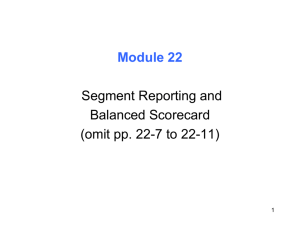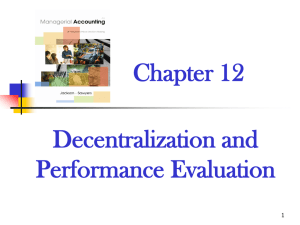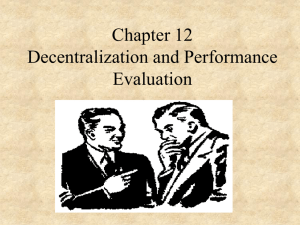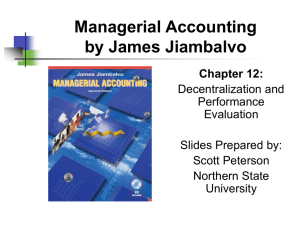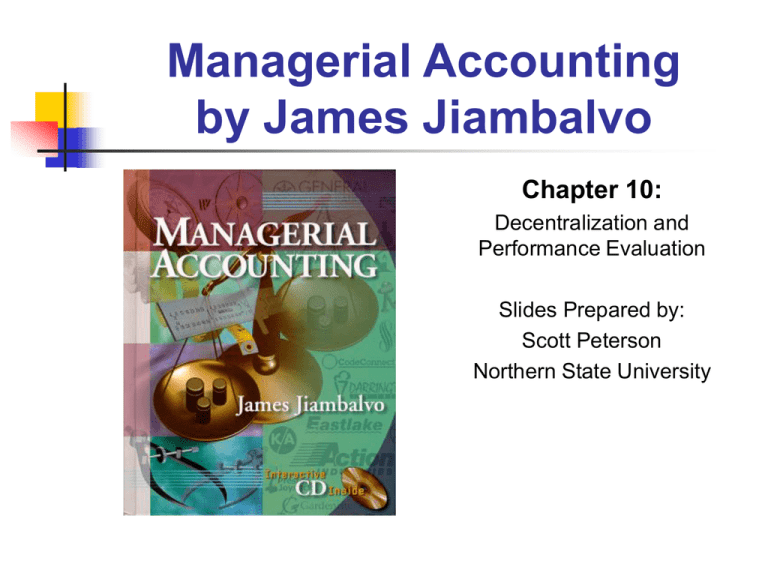
Managerial Accounting
by James Jiambalvo
Chapter 10:
Decentralization and
Performance Evaluation
Slides Prepared by:
Scott Peterson
Northern State University
Chapter Chapter 10: Decentralization
and Performance Evaluation
Chapter Themes:
Decentralized is all
about pushing
decision-making
down to those in the
best position to do it.
Responsibility
should be
commensurate with
authority.
You get what you
measure!
Learning Objectives:
1.
2.
3.
4.
List and explain the advantages
and disadvantages of
decentralization.
Explain why companies evaluate
the performance of subunits and
subunit managers.
Identify cost centers, profit
centers, and investment centers.
Calculate and interpret return on
investment (ROI).
More
Chapter Chapter 10: Decentralization
and Performance Evaluation
Decentralized is all
about pushing
decision-making
down to those in the
best position to do it.
Responsibility
should be
commensurate with
authority.
You get what you
measure!
Learning Objectives:
5.
6.
7.
Explain why using a measure of
profit to evaluate performance can
lead to return on investment (ROI)
can lead to underinvestment.
Calculate and interpret residual
income (RI) and economic value
added (EVA).
Explain the potential benefits of
using a Balanced Scorecard to
assess performance.
Advantages of Decentralization
1.
Better information
leading to superior
decisions.
Related Learning Objectives:
1.
2.
3.
4.
List and explain the advantages
and disadvantages of
decentralization.
Explain why companies evaluate
the performance of subunits and
subunit managers.
Identify cost centers, profit
centers, and investment centers.
Calculate and interpret return on
investment (ROI).
Advantages of Decentralization
1.
2.
Better information
leading to superior
decisions.
Faster response to
changing
circumstances.
Related Learning Objectives:
1.
2.
3.
4.
List and explain the advantages
and disadvantages of
decentralization.
Explain why companies evaluate
the performance of subunits and
subunit managers.
Identify cost centers, profit
centers, and investment centers.
Calculate and interpret return on
investment (ROI).
Advantages of Decentralization
1.
2.
3.
Better information
leading to superior
decisions.
Faster response to
changing
circumstances.
Increased motivation
of managers.
Related Learning Objectives:
1.
2.
3.
4.
List and explain the advantages
and disadvantages of
decentralization.
Explain why companies evaluate
the performance of subunits and
subunit managers.
Identify cost centers, profit
centers, and investment centers.
Calculate and interpret return on
investment (ROI).
Advantages of Decentralization
1.
2.
3.
4.
Better information
leading to superior
decisions.
Faster response to
changing
circumstances.
Increased motivation
of managers.
Excellent training for
future top level
executives.
Related Learning Objectives:
1.
2.
3.
4.
List and explain the advantages
and disadvantages of
decentralization.
Explain why companies evaluate
the performance of subunits and
subunit managers.
Identify cost centers, profit
centers, and investment centers.
Calculate and interpret return on
investment (ROI).
Disadvantages of Decentralization
1.
Costly duplication of
activities.
Related Learning Objectives:
1.
2.
3.
4.
List and explain the advantages
and disadvantages of
decentralization.
Explain why companies evaluate
the performance of subunits and
subunit managers.
Identify cost centers, profit
centers, and investment centers.
Calculate and interpret return on
investment (ROI).
Disadvantages of Decentralization
1.
2.
Costly duplication of
activities.
Lack of goal congruence.
[Note: goal congruence has to
do with the compatibility of
goals of the manager versus
goals of the organization.]
Related Learning Objectives:
1.
2.
3.
4.
List and explain the advantages
and disadvantages of
decentralization.
Explain why companies evaluate
the performance of subunits and
subunit managers.
Identify cost centers, profit
centers, and investment centers.
Calculate and interpret return on
investment (ROI).
Why Companies Evaluate the
Performance of Subunits and Subunit
Managers
Decentralization leads
naturally to the need to
evaluate subunits and their
managers. Companies
evaluate the performance of
subunits and subunit
managers for two reasons.
First, evaluation identifies
successful operations and
areas needing improvement.
Second, evaluating
performance influences
manager behavior.
Related Learning Objectives:
1.
2.
3.
4.
List and explain the advantages
and disadvantages of
decentralization.
Explain why companies
evaluate the performance of
subunits and subunit
managers.
Identify cost centers, profit
centers, and investment centers.
Calculate and interpret return on
investment (ROI).
Responsibility Acocunting and
Performance Evaluation
In Chapter 5 the topic of
responsibility accounting was
introduced. Recall that this
technique holds managers
responsible for only those
costs and revenues which
they can control. Taken one
step further, to implement
responsibility accounting in a
decentralized organization,
costs and revenues are
traced to the organizational
level where they can be
controlled. (see chart)
Related Learning Objectives:
1.
2.
3.
4.
List and explain the advantages
and disadvantages of
decentralization.
Explain why companies
evaluate the performance of
subunits and subunit
managers.
Identify cost centers, profit
centers, and investment centers.
Calculate and interpret return on
investment (ROI).
Responsibility Acocunting and
Performance Evaluation
Related Learning Objectives:
1.
2.
3.
4.
List and explain the advantages
and disadvantages of
decentralization.
Explain why companies
evaluate the performance of
subunits and subunit
managers.
Identify cost centers, profit
centers, and investment centers.
Calculate and interpret return on
investment (ROI).
Cost Centers, Profit Centers,
and Investment Centers
Subunits are organizational
units with identifiable
collections of related
resources and activities. A
subunit may be a department,
a subsidiary, or a division.
Subunits are sometimes
referred to as responsibility
centers and include cost
centers, profit centers, and
investment centers.
Related Learning Objectives:
1.
2.
3.
4.
List and explain the advantages
and disadvantages of
decentralization.
Explain why companies evaluate
the performance of subunits and
subunit managers.
Identify cost centers, profit
centers, and investment
centers.
Calculate and interpret return on
investment (ROI).
Cost Centers
A cost center is a subunit that
has responsibility for controlling
costs but does not have
responsibility for generating
revenue.
Examples: janitorial, computer
service, and production
departments.
Managerial goal: to provide
services at a reasonable cost to
the company.
Evaluation: compare
budgeted/standard costs with
actual costs.
Related Learning Objectives:
1.
2.
3.
4.
List and explain the advantages
and disadvantages of
decentralization.
Explain why companies evaluate
the performance of subunits and
subunit managers.
Identify cost centers, profit
centers, and investment
centers.
Calculate and interpret return on
investment (ROI).
Profit Centers
A profit center is a subunit that
has responsibility for generating
revenues as well as for
controlling costs.
Examples: copier and camera
divisions of an electronics firm.
Managerial goal: to maximize
profit (revenues – expenses) for
the division.
Evaluation: profit from the
current year may be compared
with budget or previous years or
compared with with other profit
centers on a relative basis.
Related Learning Objectives:
1.
2.
3.
4.
List and explain the advantages
and disadvantages of
decentralization.
Explain why companies evaluate
the performance of subunits and
subunit managers.
Identify cost centers, profit
centers, and investment
centers.
Calculate and interpret return on
investment (ROI).
Investment Centers
An investment center is a
subunit that has
responsibility for generating
revenues, controlling costs,
and investing in assets.
Since managers of
investment centers have
control over inventory,
receivables, equipment
purchases and so on, it
makes sense to hold them
responsible for generating
some kind of return on them.
More
Related Learning Objectives:
1.
2.
3.
4.
List and explain the advantages
and disadvantages of
decentralization.
Explain why companies evaluate
the performance of subunits and
subunit managers.
Identify cost centers, profit
centers, and investment
centers.
Calculate and interpret return on
investment (ROI).
Investment Centers
Examples: Nordstrom, Inc.
subunit Faconnable.
Managerial goal: to maximize
return on investment.
Evaluation: rate of return (%)
relative to a
benchmark/budget rate of
return or relative to other
investment center rates of
return.
Related Learning Objectives:
1.
2.
3.
4.
List and explain the advantages
and disadvantages of
decentralization.
Explain why companies evaluate
the performance of subunits and
subunit managers.
Identify cost centers, profit
centers, and investment
centers.
Calculate and interpret return on
investment (ROI).
Evaluating Investment
Centers with ROI
One of the primary tools for
evaluating the performance of
investment centers is return on
investment. ROI is calculated as
follows:
ROI
=
Income
Invested Capital
Since ROI focuses on income
and investment, it has a natural
advantage over income (alone)
as a measure of performance. It
removes the bias of larger
investment over smaller
investment.
More
Related Learning Objectives:
1.
2.
3.
4.
List and explain the advantages
and disadvantages of
decentralization.
Explain why companies evaluate
the performance of subunits and
subunit managers.
Identify cost centers, profit
centers, and investment centers.
Calculate and interpret return
on investment (ROI).
Evaluating Investment
Centers with ROI
Some companies break ROI
down into two components:
profit margin and investment
turnover as follows:
Related Learning Objectives:
1.
2.
Prof. Marg. Turnover
3.
ROI = Income x Sales
Sales
Inv. Capital
4.
List and explain the advantages
and disadvantages of
decentralization.
Explain why companies evaluate
the performance of subunits and
subunit managers.
Identify cost centers, profit
centers, and investment centers.
Calculate and interpret return
on investment (ROI).
Measuring Income and Invested
Capital When Calculating ROI
In calculating ROI, companies
measure “income” in a
variety of ways; net income,
income before interest and
taxes, controllable profit…
The text uses the commonly
used net operating profit after
taxes, NOPAT. This formula
does not hold managers
responsible for interest.
More
Related Learning Objectives:
1.
2.
3.
4.
List and explain the advantages
and disadvantages of
decentralization.
Explain why companies evaluate
the performance of subunits and
subunit managers.
Identify cost centers, profit
centers, and investment centers.
Calculate and interpret return
on investment (ROI).
Measuring Income and Invested
Capital When Calculating ROI
Further, invested capital is
measured in a variety of ways
In the text, invested capital is
measured as total assets noninterest-bearing current
liabilities (accounts payable,
income taxes payable, and
accrued liabilities).
Related Learning Objectives:
1.
2.
3.
4.
List and explain the advantages
and disadvantages of
decentralization.
Explain why companies evaluate
the performance of subunits and
subunit managers.
Identify cost centers, profit
centers, and investment centers.
Calculate and interpret return
on investment (ROI).
Problems with Using ROI
A major problem with ROI is that
the denominator, invested
capital, is based on historical
costs net of depreciation. As
those assets become fully
depreciated, the invested capital
denominator becomes extremely
low and the ROI number quite
high. And to compound the
problem, managers may
therefore be compelled to put off
purchases of new equipment
necessary for long-term
success. They “underinvest.”
Related Learning Objectives:
1.
2.
3.
4.
List and explain the advantages
and disadvantages of
decentralization.
Explain why companies evaluate
the performance of subunits and
subunit managers.
Identify cost centers, profit
centers, and investment centers.
Calculate and interpret return
on investment (ROI).
Problems of Overinvestment and
Underinvestment: You Get What You
Measure
Additional problems with ROI
exist. Managers of investment
centers with high ROI’s may
be unwilling to invest in
assets that will dilute their
current ROI. This will lead to
underinvestment. Conversely,
evaluation in terms of profit
can lead to overinvestment.
Related Learning Objectives:
5.
6.
7.
Explain why using a measure of
profit to evaluate performance
can lead to return on
investment (ROI) can lead to
underinvestment.
Calculate and interpret residual
income (RI) and economic value
added (EVA).
Explain the potential benefits of
using a Balanced Scorecard to
assess performance.
Evaluation in Terms of Profit Can
Lead to Overinvestment
As noted in Chapter 7, we
would like managers to invest
in assets that earn a return in
excess of the cost of capital.
Since “You Get What You
Measure,” managers may
overinvest to grow profits
(because their compensation
package is based on total
profits) even though the
return on invested capital is
less than the cost of capital.
Related Learning Objectives:
5.
6.
7.
Explain why using a measure of
profit to evaluate performance
can lead to return on
investment (ROI) can lead to
underinvestment.
Calculate and interpret residual
income (RI) and economic value
added (EVA).
Explain the potential benefits of
using a Balanced Scorecard to
assess performance.
Evaluation in Terms of ROI Can
Lead to Underinvestment
Perhaps the solution to the
overinvestment problem on
the previous slide is to
measure performance based
on ROI. The problem here is
that managers will have a
tendency not to invest at less
than their current ROI even if
this reduced return is greater
than the cost of capital.
Related Learning Objectives:
5.
6.
7.
Explain why using a measure of
profit to evaluate performance
can lead to return on
investment (ROI) can lead to
underinvestment.
Calculate and interpret residual
income (RI) and economic value
added (EVA).
Explain the potential benefits of
using a Balanced Scorecard to
assess performance.
Other Measures Used in
Evaluation
An approach to solving the
overinvestment and
underinvestment problems
involves use of residual
income or a related method,
economic value added. A new
approach, the Balanced
Scorecard, goes beyond
financial measures to include
multiple performance
dimensions.
Related Learning Objectives:
5.
6.
7.
Explain why using a measure of
profit to evaluate performance can
lead to return on investment (ROI)
can lead to underinvestment.
Calculate and interpret residual
income (RI) and economic
value added (EVA).
Explain the potential benefits of
using a Balanced Scorecard to
assess performance.
Residual Income (RI) and
Economic Value Added (EVA)
Residual Income (RI) is the net
operating profit after taxes of an
investment center in excess of
the profit required for the level of
investment. Specifically:
Related Learning Objectives:
5.
6.
RI = NOPAT - Cost of Capital x
Investment
7.
RI has the potential to solve both
the overinvestment and
underinvestment problem
because it compels investment
in the range between cost of
capital and current ROI. More
Explain why using a measure of
profit to evaluate performance can
lead to return on investment (ROI)
can lead to underinvestment.
Calculate and interpret residual
income (RI) and economic
value added (EVA).
Explain the potential benefits of
using a Balanced Scorecard to
assess performance.
Residual Income (RI) and
Economic Value Added (EVA)
Economic Value Added, EVA, is a
performance measure developed
by the consulting firm Stern
Stuart. It is basically RI adjusted
for “accounting distortions.” A
primary distortion is related to
research and development
(R&D). Under GAAP R&D is
required to be expensed. Under
EVA, R&D is capitalized and
amortized over a number of
future accounting periods. EVA
has gained considerable
attention in the financial press.
Related Learning Objectives:
5.
6.
7.
Explain why using a measure of
profit to evaluate performance can
lead to return on investment (ROI)
can lead to underinvestment.
Calculate and interpret residual
income (RI) and economic
value added (EVA).
Explain the potential benefits of
using a Balanced Scorecard to
assess performance.
Using a Balanced Scorecard to
Evaluate Performance
A problem with assessing
performance with only financial
measures, like profit, ROI, and
RI/EVA, is that financial
measures are “backward
looking.” Balanced Scorecard is
a set of performance measures
constructed for four dimensions
of performance:
1. Financial
2. Customer
3. Internal processes
4. Innovation
More
Related Learning Objectives:
5.
6.
7.
Explain why using a measure of
profit to evaluate performance can
lead to return on investment (ROI)
can lead to underinvestment.
Calculate and interpret residual
income (RI) and economic value
added (EVA).
Explain the potential benefits of
using a Balanced Scorecard to
assess performance.
Using a Balanced Scorecard to
Evaluate Performance
Balanced Scorecard
uses performance
measures that are tied to
the company’s strategy
for success. Balance is a
key factor using this
technique.
More
Related Learning Objectives:
5.
6.
7.
Explain why using a measure of
profit to evaluate performance can
lead to return on investment (ROI)
can lead to underinvestment.
Calculate and interpret residual
income (RI) and economic value
added (EVA).
Explain the potential benefits of
using a Balanced Scorecard to
assess performance.
Using a Balanced Scorecard to
Evaluate Performance
Note how balance is achieved:
1.
Performance is assessed
across a balanced set of
dimensions (financial,
customer, internal
processes, and innovation).
2.
Quantitative measures are
balanced with qualitative
measures.
3.
There is a balance of
backward-looking measures
More
Related Learning Objectives:
5.
6.
7.
Explain why using a measure of
profit to evaluate performance can
lead to return on investment (ROI)
can lead to underinvestment.
Calculate and interpret residual
income (RI) and economic value
added (EVA).
Explain the potential benefits of
using a Balanced Scorecard to
assess performance.
Using a Balanced Scorecard to
Evaluate Performance
Related Learning Objectives:
5.
6.
7.
Explain why using a measure of
profit to evaluate performance can
lead to return on investment (ROI)
can lead to underinvestment.
Calculate and interpret residual
income (RI) and economic value
added (EVA).
Explain the potential benefits of
using a Balanced Scorecard to
assess performance.
Appendix A
Transfer Pricing
Market Price as the
Transfer Price
Market Price and
Opportunity Cost
Variable Cost as the
Transfer Price
Full Cost Profit as the
Transfer Price
Negotiated Transfer
Prices
Transfer Pricing and
Income Taxes in an
International Context
Related Learning Objectives:
A1. Discuss the use of market price,
variable cost, full cost plus
profit, and negotiation in setting
transfer prices.
Transfer Pricing
In many cases, subunits
“sell” goods or services to
other subunits within the
same company. For example
in the automobile
manufacturing industry,
batteries manufactured in one
division may be sold to other
divisions which manufacture
autos. Various approaches to
pricing exist in practice: (1)
market prices, (2) variable
costs, (3) full cost plus profit,
and (4) negotiated prices.
Related Learning Objectives:
A1.
Discuss the use of market
price, variable cost, full cost
plus profit, and negotiation in
setting transfer prices.
Market Price as the Transfer
Price
The transfer price in this
method would be the
same as between the
subunit and any other
customer at “arm’s
length.” The external
market price is an
excellent choice
because the buying and
selling divisions are
treated as independent
companies.
Related Learning Objectives:
A1.
Discuss the use of market
price, variable cost, full cost
plus profit, and negotiation in
setting transfer prices.
Market Price and Opportunity
Cost
Opportunity cost is the
foregone benefit or increased
cost of selecting one
alternative over another. The
selling division has a choice
between selling to the related
division or into an open
market. The determining
factor in deciding whether or
not to sell to the related
division is the impact to the
firm (overall) of the decision,
not one or the other of the
divisions involved.
Related Learning Objectives:
A1.
Discuss the use of market
price, variable cost, full cost
plus profit, and negotiation in
setting transfer prices.
Variable Cost as the Transfer
Price
In some cases the transferred
product is unique and is not
sold in the open market. In
this case variable cost may
be a good transfer price. The
main reason is that it conveys
accurate opportunity cost
information. And when not
external market for the
product exists, the
opportunity cost of producing
and selling the product is
variable cost per unit.
Related Learning Objectives:
A1.
Discuss the use of market
price, variable cost, full cost
plus profit, and negotiation in
setting transfer prices.
Full Cost Plus Profit as the
Transfer Price
The problem with variable
cost transfer pricing is that
the selling division cannot
earn a profit on production on
the transferred product.
Therefore, the price may not
be acceptable to management
of the selling company. So,
many companies add a profit
margin to the full cost of
production and use this sum
as the transfer price. The
problem is that Full Cost Plus
Profit may not measure the
opportunity cost of producing
the product.
Related Learning Objectives:
A1.
Discuss the use of market
price, variable cost, full cost
plus profit, and negotiation in
setting transfer prices.
Negotiated Transfer Prices
One of the benefits of
decentralization is that managers
who are delegated decisionmaking responsibility tend to be
highly motivated. To encourage
autonomy, some companies
allow managers to negotiate
transfer prices. Again, the
problem is that this price may
not reflect the opportunity cost
of producing and selling the
product. More likely it will reflect
the relative bargaining prowess
of individual managers.
Related Learning Objectives:
A1.
Discuss the use of market
price, variable cost, full cost
plus profit, and negotiation in
setting transfer prices.
Transfer Pricing and Income
Taxes in an International Context
Income tax rates vary
significantly between countries.
And when goods are transferred
between countries, these tax
situations may create incentives
for relatively high or low transfer
prices. All else equal, this
creates a bias toward having
high transfer prices when selling
a product from a low tax country
to a high tax country and having
a low transfer price when selling
a product from a high tax
country to a low tax country.
Related Learning Objectives:
A1.
Discuss the use of market
price, variable cost, full cost
plus profit, and negotiation in
setting transfer prices.
Copyright
© 2001 John Wiley & Sons, Inc. All rights reserved. Reproduction or
translation of this work beyond that permitted in Section 117 of the 1976
United States Copyright Act without the express written permission of the
copyright owner is unlawful. Request for further information should be
addressed to the Permissions Department, John Wiley & Sons, Inc. The
purchaser may make back-up copies for his/her own use only and not for
distribution or resale. The Publisher assumes no responsibility for errors,
omissions, or damages, caused by the use of these programs or from the
use of the information contained herein.

